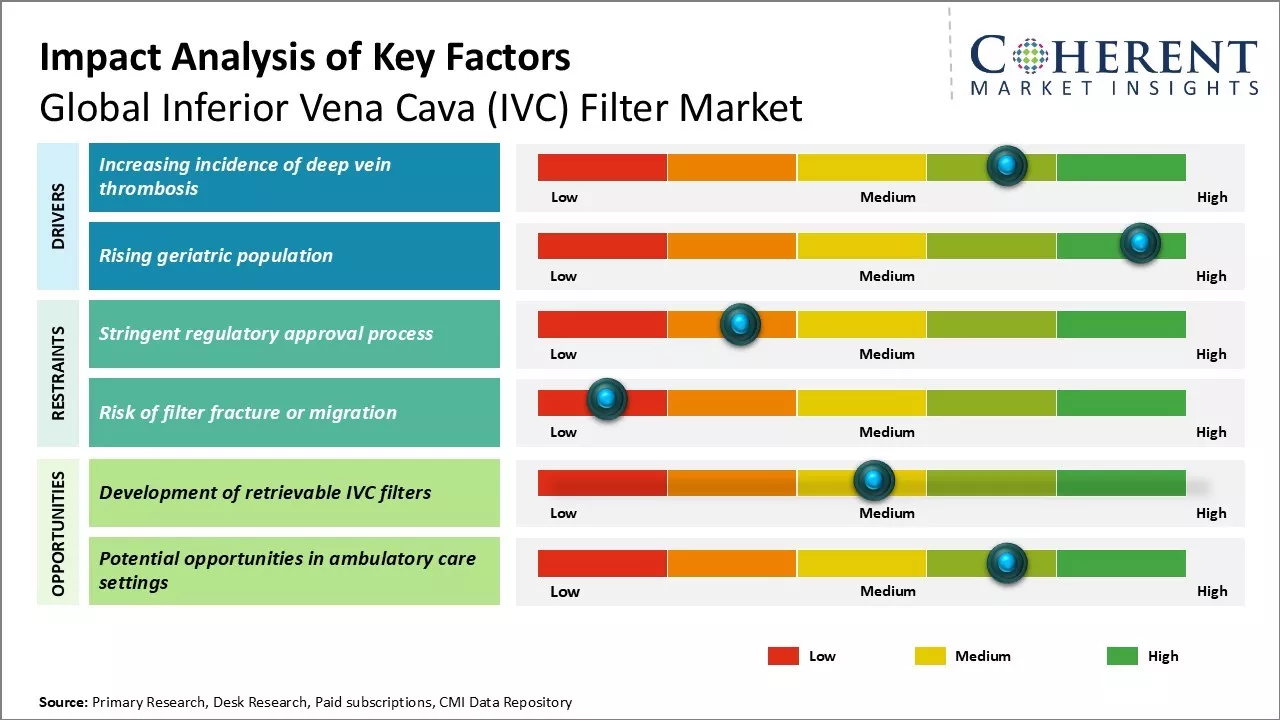Global inferior vena cava (IVC) filter market is estimated to be valued at USD 772.1 Mn in 2024 and is expected to reach USD 1,393.1 Mn by 2031, exhibiting a compound annual growth rate (CAGR) of 8.8% from 2024 to 2031.

To learn more about this report, request sample copy
The market growth is driven by growing prevalence of deep vein thrombosis and preference of minimally invasive procedures for its treatment. There has been rising demand for retrievable IVC filters due to associated risks of permanent IVC filters such as filter migration and fracture.
Market Driver - Increasing incidence of deep vein thrombosis
Rising incidence of deep vein thrombosis (DVT) can drive the market growth. As modern lifestyles become more sedentary with longer periods of immobility due to travel, binge watching or work commitments on computers and mobile devices, there has been increase in risk of developing blood clots in the leg veins. Prolonged sitting or lack of physical movement restricts normal blood flow and predisposes the formation of clots. With increasing stress levels, unhealthy diets and rising obesity rates, all of which are risk factors for DVT, more people are experiencing episodes of clots in the legs.
Rising caseload of DVT has further amplified in hospital settings. Patients undergoing complex surgeries or sustaining severe injuries that require long stays in bed are at high risk of developing this disease. With rapid growth in the number of surgical procedures being performed globally and better access to emergency care, there has been rise in incidences related to medical interventions. Elderly populations who tend to have limited mobility are especially vulnerable as are cancer patients undergoing chemotherapy. Growing cases of cancer, obesity and lifestyle diseases can trigger DVT.
These factors have resulted in a considerable rise in number of people diagnosed with DVT each year. As DVT needs to be aggressively managed to prevent its potentially life-threatening complication of pulmonary embolism, medical interventions have become crucial. When medications alone are insufficient due to high risk or recurring clots, insertion of inferior vena cava (IVC) filters has emerged as an important option. IVC filters are minimally invasive devices temporarily placed in the vena cava to trap blood clots entering the lungs. Rising prevalence of DVT can boost demand for alternate treatment avenues like IVC filters.
Rising geriatric population
The world population is aging at an unprecedented rate with people generally living longer due to advanced healthcare and lifestyle changes. It is estimated that by 2050, 1 in 6 people globally will be aged 65 years and above. This translates to an enormous expansion of the geriatric demographic worldwide with projections of over 2 billion senior citizens on the planet. As people grow older, their risk of developing chronic health issues rises in tandem. Things like reduced mobility due to arthritis or other age-related impairments curb normal activity levels considerably. The lack of movement coupled with other common comorbidities in the elderly population such as diabetes, heart disease and vascular conditions drastically raises their vulnerability to DVT.
Advanced age itself is considered a significant risk factor because aging diminishes circulatory function and speeds up blood coagulation. It becomes more difficult for the aging body to regulate normal blood flow and clotting tendencies within the leg veins. Therefore, just by virtue of living longer, elderly citizens have a higher probability of experiencing DVT at some point. Managing DVT in the geriatric group is challenging due to coexisting morbidities and healing capacities. Once DVT strikes, it is very common for seniors to suffer recurrences due to persistent pro-clotting tendencies. This makes IVC filters reliably effective alternatives when anti-coagulation alone is insufficient for the older population.
With lifetimes expanding worldwide, there will be increase in proportion of those aged 65 years and above requiring treatment for DVT and related conditions. Catering to the unique healthcare needs of this demographic can boost demand for specialized products like IVC filters. As people celebrate greater longevity, medical device markets must simultaneously address the complex health challenges of advanced age.
Joining thousands of companies around the world committed to making the Excellent Business Solutions.
View All Our Clients